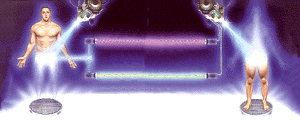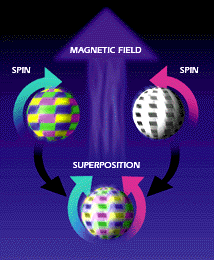Time Travel Research Center © 2005 Cetin BAL - GSM:+90 05366063183 - Turkey/Denizli

Atom by atom, the impossible dream of teleportation moves off the pages of science fiction.
 |
| The traveler would be scanned to create the entangled pairs (top beam). Unfortunately, he would be destroyed in the process. |
BY JIM WILSON
Illustrations by Jeff Mangiat
This time last year the idea of teleporting matter existed only in
science fiction and the dense equations of quantum theory. As a result of
experiments conducted in Europe since then, the notion that matter can be
moved from here to there without being anywhere in between has achieved new
respectability.
Understand that a teleportation system won't work anything at all like
the transporter that Captain Kirk used to beam down to class M planets. That
fictional machine "beamed" the body mass of crew members into space as
energy. The type of teleportation system being discussed by scientists such
as Charles H. Bennetta physicist at the IBM T.J. Watson Research Center in
Yorktown Heights, N.Y., who conceived of the current approachwould send
only information about the atoms that compose the traveler. At the
destination this information would then be used to assemble a copy of the
traveler from local materials.
This may seem as preposterous as Scotty managing to keep his accent
after a lifetime spent working with people who talk like they're from
Jersey, save one fact: Researchers have already proved it is possible to "teleport"
this sort of quantum information about a photon, or packet of light. The
Austrian and Italian teams that did this work are now designing experiments
that would enable them to teleport an electron.
Electronsthe lightweight, negatively charged particles that orbit the
nuclei of atomsare responsible for most everything we see around us. Not
the least of which are our bodies. Electrons perform many functions,
including coupling atoms together to form molecules.
One of the most important characteristics of an electron is a property
called spin. As the diagram on the opposite page shows, an electron can have
either a clockwise or counterclockwise spin relative to a magnetic field.
Physicists describe the spin as being "up" or "down." Under certain
circumstances electrons created at the same moment can enter into what is
called an "entangled state." From that time forward, they remain linked even
though they are physically separated.
It's like this: Imagine for a moment that you take a pair of coins from
your pocket and give one to a friend, who travels to, say, Hong Kong. When
your friend arrives he calls you on the phone and the two of you start
flipping your coins simultaneously. Now imagine that for some reason every
time your coin lands heads-up, his coin lands heads-down. And every time
your coin lands tails-up, his coin lands tails-down. Impossible, right?
Yet that's the way it works in the subatomic realm. Just substitute
entangled electrons for coins, and spin for heads and tails. The rules of
quantum theory require that if the spin on one entangled electron is up, the
spin of the other must be down. Even if the two electrons are a thousandor
10 millionmiles apart.
Superpositions
Hang on, things are about to get stranger. Before a real coin hits the ground it has an equal chance of landing heads or tails. However, the rules of quantum theory require electrons in an entangled state each to have spin that is both up and down.
 |
| In superposition of two electrons, spin is both up and down. |
Their spins don't become fixed until the electrons are "observed" see
"Executing Schrödinger's Cat," Oct. 1997. Bennett believes a particle's
ability to exist in this "superposition" holds the key to building a real
teleporter.
Stripped to its basics, a teleporter would work something like this: An
object is scanned atom by atom. This process breaks up the atom to create
entangled pairs of particles. The entangled pairs are stretched so that the
superposition extends between the transmitting and receiving points. At the
receiving end, the information contained in the "superposition" of entangled
particles is used to duplicate the original quantum conditionsin atoms
drawn from the immediate surroundings. You disintegrate at one end and pop
out at your destination, literally a new person.
Don't cancel your frequent flyer programs just yet. The process needs to
be scaled up a bit first. For their next step, teams at the University of
Innsbruck in Austria and the University of Rome are preparing to teleport an
electron. A whole atom and molecule come next. Within a decade, Anton
Zeilinger of the Austrian team believes it will be possible to teleport a
small virus.
Teleporting the flu may seem a dubious enterprise. But consider this: If
a small package of genetic material could be teleported, why couldn't the
genome containing the blueprint for the human body?
Alıntı:
http://www.jeffeco.com/teleport.htm
Hiçbir yazı/ resim izinsiz olarak kullanılamaz!! Telif hakları uyarınca bu bir suçtur..! Tüm hakları Çetin BAL' a aittir. Kaynak gösterilmek şartıyla siteden alıntı yapılabilir.
The Time Machine Project © 2005 Cetin BAL - GSM:+90 05366063183 -Turkiye/Denizli
Ana Sayfa /index /Roket bilimi /![]() E-Mail /CetinBAL/Quantum Teleportation-2
E-Mail /CetinBAL/Quantum Teleportation-2
Time Travel Technology /Ziyaretçi Defteri /UFO Technology/Duyuru